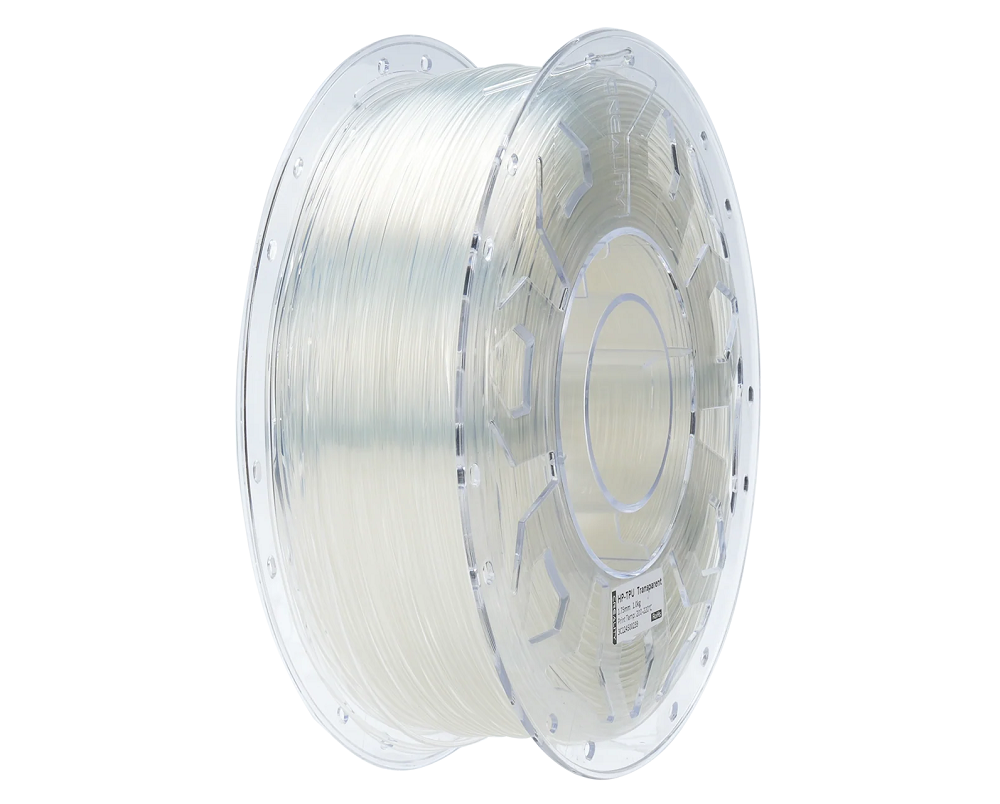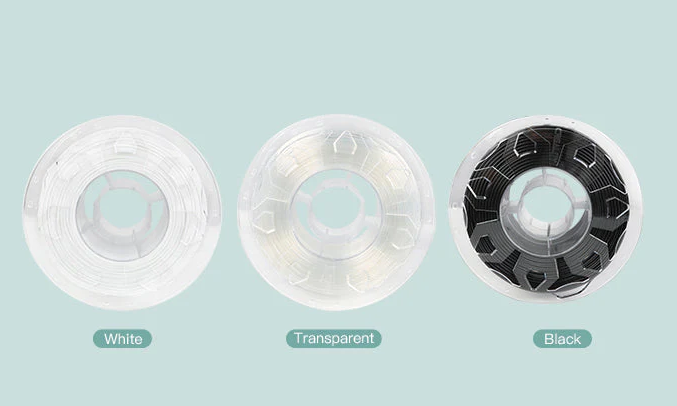If you've bought a 3D printer, you must be excited about all the incredible stuff you can print. But there's a lot of information available, due to which people often get confused about printing plastics.
So what's the truth? Can you 3D print clear plastic?
Yes. But you've to take some precautions before jumping into printing. Achieving transparent results depends on your printer, material, and, most importantly, how you finish the model.
You need to understand that transparency means you can see through it like glass. Meanwhile, translucent is when light is passing through it, but the image appears foggy. In opaque, no light passes, such as in metal.

So when people explore 3D printing transparent plastic, they want maximum transparency. The core aspect is having a high-quality printer. Creality offers machines and materials that make clear plastic 3D printing easier.
Let's get started and learn how you can do clear 3d printing.
What Makes Plastic 3D Print Transparent or Cloudy?
Clarity in 3D printed parts is directly proportional to light. You need to understand how it interacts with materials.
Let's suppose light hits a surface that's rough or layered. It'll scatter and lead to cloudiness. In FDM printing, the object is usually built layer-by-layer. But there's one tiny problem.
These lines or tiny air particles can trap between layers. So, light bends away from a straight path, and the object isn't clear. If you look closely, then you'll notice that some transparent films have micro-impurities or aren't clear in raw form. It changes the trajectory of light through the final print.
So you shouldn't use the 3D printer with FDM technology?
You should. But to get excellent results, optimize it properly.
Best Creality Printers for Clear Plastic
By now, you already know the importance of a 3D printer while printing. One poor choice and you might have to suffer the consequences of choosing the wrong printer forever. Because a printer is a one-time and long-term investment.
But don't worry. We have handpicked a few 3D printers that are ideal for 3D printing clear plastics. Here's a quick overview of all so you can choose which one's best to print on clear plastic.
|
Printer Model
|
Type
|
Ideal For
|
Transparency Capability
|
|
Ender-3 V3 KE / Neo
|
FDM/FFF
|
Beginners, hobbyists using PETG or PLA
|
Translucent to semi-clear with tuning
|
|
K1 / K1 Max
|
FDM/FFF
|
High-speed prototyping, improved bonding
|
Better clarity due to tighter layer fusion
|
|
Halot-One
|
Resin (SLA)
|
Small transparent models and parts
|
Smooth, clear prints with polishing
|
|
Halot-Mage
|
Resin (SLA)
|
Larger, highly detailed transparent resin prints
|
Near-glass clarity with post-processing
|
Top Filaments & Resins for Clear Printing
You should use transparent 3d printing filament or maybe opt for something else to print clear plastic. No resin is the only good option. And the noise continues.

At Creality, we offer you the best options so you can save yourself from the headache of researching on 10 different websites. Here are the top filaments and resins for clear plastic 3D printing.
FDM Filaments:
-
Transparent PETG: It's tough, chemical resistant, and competitively easier to print. Highly recommended for lampshades, containers, and light covers.
-
PLA Crystal Clear: Easy to use and available from several suppliers. Great for decorative models that need minimal structural stress.
-
Polycarbonate (PC): Strong, high heat resistance, and prints with exceptional clarity if printed hot and slowly.
Resins:
-
Creality Clear Resin: Specially formulated for 3D printing. You can use it for printing miniatures, optical components, and prototyping. In a nutshell, print any product where clarity is a top priority,
Specialty filaments:
-
PolySmooth: It's a unique material that works really well with isopropanol smoothing. It should be your go-to choice if you want to print artistic pieces and displays where smoothness matters.
Best Printer Settings for Clear Results
Following the basic steps and guides is good but not enough. So, if you're printing on an FDM printer, here are a few settings you need to check.
First, check the nozzle temperature and ensure proper layer fusion. Don't be hasty in the process. Keep the speed slow and check layers thickness. (~0.2–0.3 mm)
If you want single-wall clarity on vases or display parts, then enable Vase Mode.
Pro Tip: Use Creality Print to fine-tune these variables.
Post-Processing Methods to Improve Clarity
Most people perform all the steps, but they still don't achieve glass-like finish. Do you know why?
Because they don't do post-processing, here's how you can perform this crucial process.
-
Sanding: Start with 400 grit and slowly increase it up to 2000. You can use wet sand because it prevents melting.
-
Polishing: Plastic polish is recommended for this, but you can even use toothpaste. Use a rotary tool or microfiber cloth for better fishing.
-
Clear Coating: Apply a thin layer of acrylic spray or resin. It'll increase the smoothness and clarity of the surface.
-
Resin Prints: Lastly, polish with microfiber or dip-coat with clear resin.
Use Cases for Transparent 3D Prints
3D prints aren't just for making cute toys or art. The world is advancing, and this technology is employed in so many areas.
Source - 3dinsider
With a 3D printer, sky's the limit. Here are a few interesting projects you can do with it.
-
Lighting Projects: Lampshades, diffusers, and glow-through enclosures.
-
Medical Models: Anatomical parts for detailed study.
-
Engineering Prototypes: Fluid models, sensor enclosures.
-
Packaging & Product Design: Transparent lids or cases.
This is just the tip of the iceberg. If you're creative, then you can do a lot of interesting projects with 3D printers. Many people have turned 3d printing transparent plastic into their business. With this guide and Creality printer, you can offer transparent 3d printing services to consumers.
Common Problems & Solutions
The most common problem in these prints is a cloudy surface. You can eliminate the issue by using better filament. But what if the layer is separating?
Then, increase the nozzle temperature and reduce print speed. It will help you get rid of the annoying problem.
You've poured a lot of effort into printing. But there are bubbles or internal haziness. It can potentially ruin your print.
This issue arises because of filament/resin. So make sure to dry it before using.
Note: Want to know more about printing, like How To Print Glass? Then check out the Creality blogs section now.
Why Creality Is Ideal for Clear Printing
You might ask yourself: Why Choose Creality? There are tons of other printer companies in the market. Why should you ignore all of them and purchase from Creality?
Creality builds affordable printers without any compromise on quality, you don't have to go to 20 different shops to get extruders, glass beds, etc, because Creality will offer you those along with the printer.
But what if there's any issue?
Then don't worry. Creality customer support is available to assist you. If you still have any confusion then check out Creality detailed tutorials on YouTube.
Final Tips & Summary
If you follow the steps and precautions mentioned in this article, then you can easily 3D print clear plastics. But focus on the right approach so you can turn hazy translucency to crystal clear transparency.
Use FDM for strong and translucent parts. If you're aiming for optical-grade clarity, then opt for resin. In a nutshell,
Best Results = Creality Printer + Correct Filament + Sanding and Polishing
If you want to find the best printer for your printing needs, then get in touch with us now. Get ready to create stunning 3D print clear plastics with Creality.
FAQs
Q1: Which Creality printer is best for clear plastic?
It depends. If you're using FDM, then K1 or Ender-3 V3 KE is a good option. But for resin, Halot-Mage or Halot-One is highly recommended.
Q2: Which filament is most transparent?
The most popular material is transparent PETG. For glass-like results, use clear resin or check out options on the Creality store.
Q3: Can I print clear plastic without post-processing?
You can skip post-processing. But the problem is that print will not be transparent; instead, it'll be translucent. So, post-processing is critical for clarity.
Q4: Does Creality sell clear filament or resin?
Yes. Creality is a one-stop shop for everything you need for printing. You can find clear PLA, PETG, clear resin, and much more on the Creality Official Store.
Q5: Can clear prints turn yellow over time?
It's possible. To avoid this, avoid over-curing and store prints away from UV light. It'll reduce the chances of yellowing of prints.
